The 1993 ICAO report shows data from what is the recovered KAL007 DFDR (Digital Flight Data Recorder). This was handed over by President Yeltsin in 1992. It also includes communications between Anchorage and KAL007 and a transcript of the CVR. Comparison between these sets of information is enlightening. This is despite ICAO explicitly stating “A list of 191 radio transmissions from KE 007 recorded on the DFDR during the last flight was compiled. The time and duration of each transmission were noted together with which radio was used. The DFDR information was studied in detail to eliminate any false indications of transmitter keying due to synchronization losses in the recovered serial digital data.”
Sundstrand DFDR, model 573A, type 981-600009-010, which carried the serial number 3069. The ICAO was able to verify that the mechanism in its possession was a Sundstrand model 573A, but was unable to identify the type of device. In paragraph 1.14.3.4.1 the ICAO report states “A handwritten “S/N 3069″ was on the plate.
In the 1993 ICAO report paragraph 1.14.3.3.2 states these parameters were supposed to be recorded according to Korean airlines: UTC, VOR/ILS localizer and glide slope, engine pressure ratio for engines No.1 and 4, and GPWS. However, these parameters were conveniently ‘missing’ off the DFDR recording.
On page 27 of the ICAO report it states that a Sundstrand 573A DFDR has a tape had a length of approximately 800 ft which enabled it to retain the previous twenty-five hours of information. However on page 30 of the same report it is stated there were 27hrs of data recorded. It is also noted that Spliced joints were found at approximately 108, 440, 442 and 463 ft from the beginning of the tape.
The lack of UTC on the recording and the hand written serial number should be reason enough to view the data as extremely suspicious but ICAO make no reference to this. A closer view of the data itself exposes the complete and utter DFDR forgery.
Please refer to ICAO Chart 6 and “RADIO COMMUNICATIONS RECORDED IN ANCHORAGE” for the following analysis.
On the preceding flight during the landing stage there was a total of 53 radio communications recorded on 5 channels (HF1&2 and VHF1,2,3) during the approximate 8 minutes of landing and taxing. During landing the crew are typically very busy and don’t have time to chatter on the radio. In addition there is zero reason to communicate on HF which is reserved for long distance communications. In the US, HF is never used by Civilian aircraft flying in US airspace.
At 12:55:07 KAL007 transmits on VHF2 the request: “Uh ground Korean Air zero zero seven taxi”. There is no recording on the DFDR of VHF2 (or any other channel) being used at this time.
At 12:55:17 KAL007 acknowledges Anchorage tower on VHF2 with the reply: “Runway three two Roger”. Again there is no recording of this on the DFDR.
At 12:58:01 KAL007 announces on VHF2 that: “Korean Air zero zero seven ready for take-off” – Again no recording on VHF2 at this time.
At 12:58:13 KAL007 acknowledges ATC permission to take off on VHF2 and commences its take off roll: “Roger one one eight three” – Again no recording on VHF2 at this time on the DFDR.
KAL007 rolls for 1 minute and 47 seconds before takeoff. However, the DFDR shows the roll was only 52 seconds before takeoff..an impossibility for a heavily loaded 747.
At 13:00:40 Anchorage APP informs KAL007 to climb to FL 310 and turn left to 220 deg. At 13:00:50 KAL acknowledges on VHF2: “Roger two two zero, climb and maintain three one zero Roger”. Not only is there no recording at this time on the DFDR but KAL007 has ALREADY commenced a turn to the left at 13:00:24 a full 16 seconds before being given permission to do so. KAL007 would also not have known in advance whether a turn to the left or right was required by air traffic control.
At 13:02:08 Anchorage APP informs KAL007 to proceed direct to Bethel when able and 007 responds on VHF2 at 13:02:13 with: “Roger, proceed direct to Bethel Roger” – Again, no such recording is recorded on the DFDR at this time on any channel.
At 13:04:41 Anchorage APP informs KAL007 to contact Anchorage Center. At 13:04:46 KAL007 responds on VHF2: “Zero zero seven good day” – No such recording on the DFDR at this time.
At 13:04:51 KAL007 states on VHF2 it is: “Anchorage Korean Air zero zero seven leaving five thousand for three one zero good morning”. Not only is there nothing recorded on the DFDR but KAL007 is already at 6000 feet at this time and at no time had stabilised its climb at 5000ft.
KAL007 makes no radio comms until 13:27:44 yet there are recordings on VHF1 and 2 simultaneously at 13:14:14 and on VHF2 at 13:27:18
No more calls from KAL007 until 13:49:57 yet 3 simultaneous calls on HF2, VHF1 and VHF2 at 13:28:54 and again at 13:30:40 on HF1, HF2 and VHF3
Almost all the of radio communications recorded between KAL007 and the ground do not match the DFDR times. In addition during the period from the pushback to the end of chart 6 at 13:33: 20 the DFDR has two recordings on HF1, 3 on HF2, 2 on VHF1, 13 on VHF2 and 6 on VHF3. Compare this to only 8 recordings on VHF2 only recorded by Anchorage. A marked up version of chart 6 below showing the discrepancies with ATC radio comms.
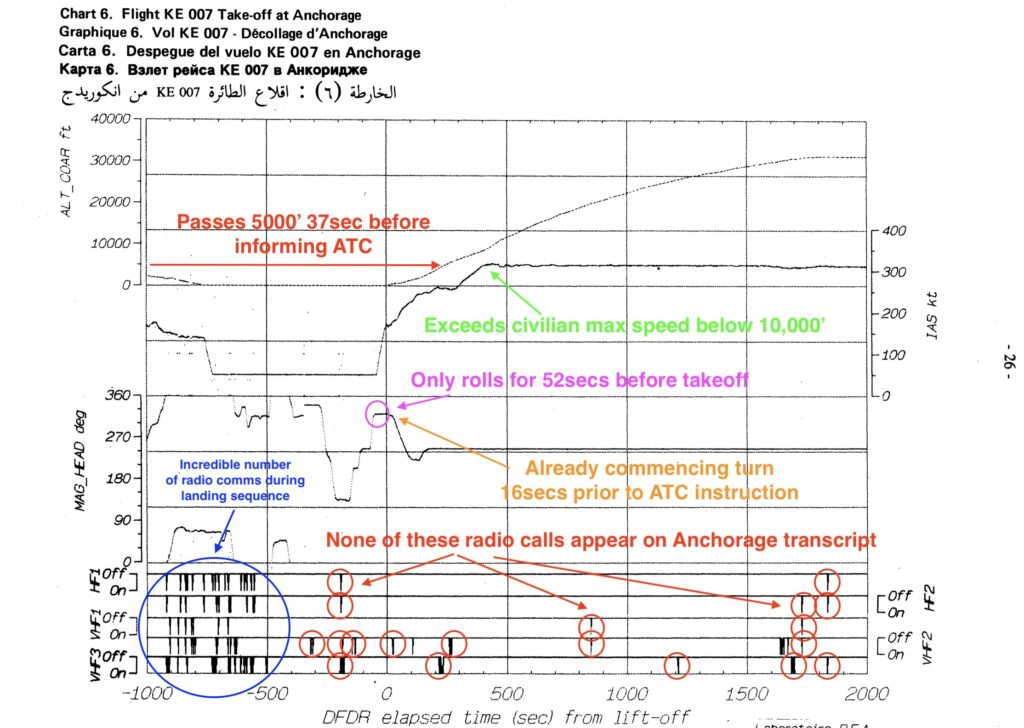
The same issue occurs when comparing the DFDR data with the CVR data for the last 30 minutes of the flight. i.e. Chart 7 with the CVR transcript. Almost all comms recorded until the last are on VHF3…yet most of the comms on DFDR are on HF1 and 2
At 18:03:19 007 on CVR VHF3: “Go ahead” – Nothing recorded on DFDR at this time on any channel
At 18:03:24 on channel VHF3 (CVR) KAL007 says: “What?” – nothing recorded on DFDR
At 18:03:30 on channel VHF3 Kal007 states: “We are … we have a pleasant chat because Mr. Kim here is giving us a little fun” – again nothing on DFDR
At 18:03:45 on channel VHF3 KAL007 states: “Study what? There is nothing to be studied … By the way, what a good season, it’s autumn. I hope I could take a day off and” – this appears on the DFDR
At 18:03:56 on channel VHF3 KAL007 states: “Why don’t you take some time off and go to Sorak Mountain” – this appears on the DFDR
At 18:04:10 on VHF3 CVR, KAL007 states: “Ah ah” – this appears on the DFDR
At 18:04:20 on VHF3 CVR, KAL007 states: “NOKKA ESTIMATE is ONE EIGHT TWO er TWO FIVE OVER” – this appears on the DFDR
At 18:04:35 on VHF3 CVR , KAL007 states: “One minute late one minute FOUR minutes faster it’s TWO FIVE” – this appears on the DFDR
At 18:04:41 on VHF3 CVR, KAL007 states: “it will be very complicated to go through customs. If you want to go faster, go faster if you want to go slower, go slower. That’s the complication” – this appears on the DFDR
At 18:04:59 KAL007 states on VHF3:”How much do you get there? How/much and which direction?” – this appears on the DFDR
At 18:05:02 KAL007 states on VHF3:” Two ZERO SIX: – this appears on the DFDR
At 18:05:07 KAL007 states on VHF3:”Um which direction, which direction ” – this appears on the DFDR
At 18:05:15 KAL007 states on VHF3:”Thirty degrees? Thirty knots?” – this appears on the DFDR
At 18:05:23 KAL007 states on VHF3: “Ahl You got so muchl We still got headwind. Headwind two hundred fifteen degrees FIFTEEN KNOTS” – this appears on the DFDR
At 18:05:40 KAL007 states on VHF3:”Well it may be like this ” – this appears on the DFDR
At 18:08:37 KAL007 states on VHF3: “Go ahead ” – this is not recorded on the DFDR
At 18:08:46 KAL007 states on VHF3:” Sure we can ” – this is not recorded on the DFDR
At 18:08:51 KAL007 states on VHF3:”ok” – this appears on the DFDR
At 18:20:21 KAL007 states on HF1: “AH ROGER KOREAN AIR ZERO ZERO SEVEN CLIMB AND MAINTAIN AT THREE FIVE ZERO LEAVING THREE THREE ZERO AT THIS TIME”
At 18:22:56 KAL007 sates on HF1:”OKYO RADIO KOREAN AIR ZERO ZERO SEVEN REACHING LEVEL THREE FIVE ZERO”
At 18:27:04 KAL007 makes its 2nd to last radio call on HF1: “ROGER KOREAN AIR ZERO ZERO SEVEN .•• (UNREADABLE) AH WE (ARE EXPERIENCING) …”
18:27:10 KAL007 makes its final radio call on HF1: “RAPID COMPRESSIONS DESCEND TO ONE ZERO THOUSAND”
In summary the DFDR records 9 HF1, 4 HF1, 4 VHF1, 4 VHF2, 8 VHF8 but the CVR states 4 HF1 and 2 on VHF3…quite a difference. The last call on HF1 (or any channel) made by KAL007 as recorded by the DFDR was at 18:14:31, yet the CVR transcript continues to 18:27:10
The DFDR (and CVR) both stopped at 18:27:46 GMT which under normal circumstances would have been the time of impact. However according to ICAO the flight continued flying till 13:38:00.
Chart 8 and 9 of the 1993 ICAO report show the DFDR stopping recording at 19675 seconds after liftoff. Also state 104 seconds after missile strike the DFDR and CVR recording stop. However on chart 7 the recordings (at least of radio comms) continue to 19719 seconds after liftoff or another 44seconds. The mag heading and altitude traces also appear to keep recording an additional 144 seconds after ICAO.
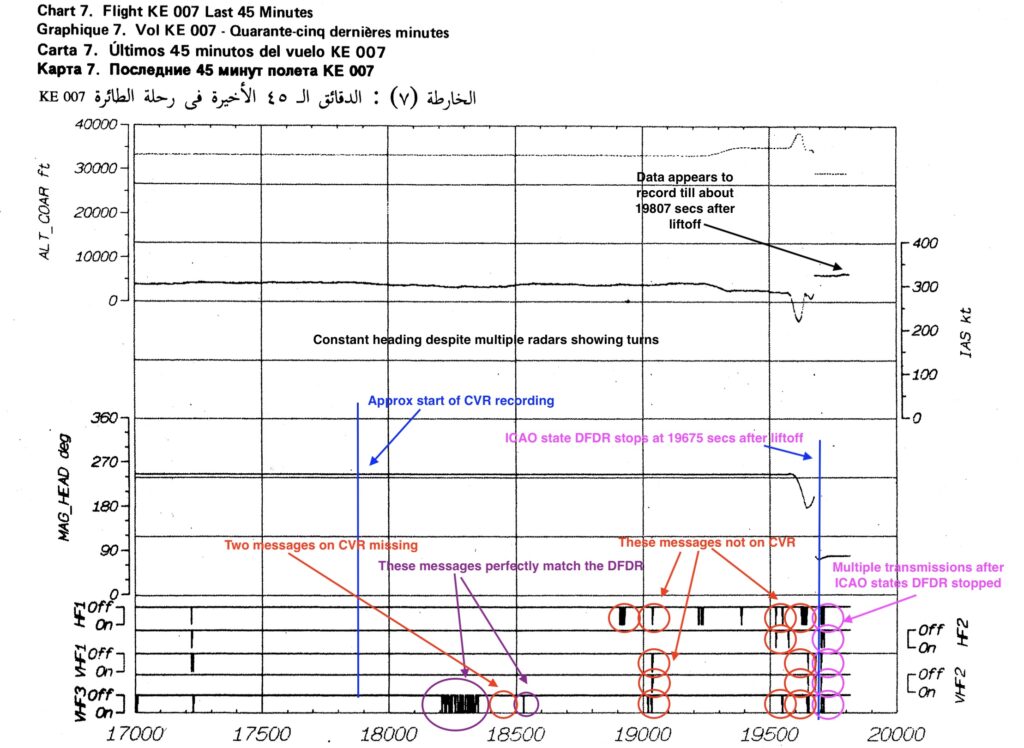
Chart 9 also differs from the CVR transcript. The last transmissions on HF as recorded by the DFDR are at 18:27:06, 18:27:09, 18:27:15 and 18:27:21. However on the CVR these recordings are at 18:26:55, 18:26:57, 18:27:04, 18:27:10.
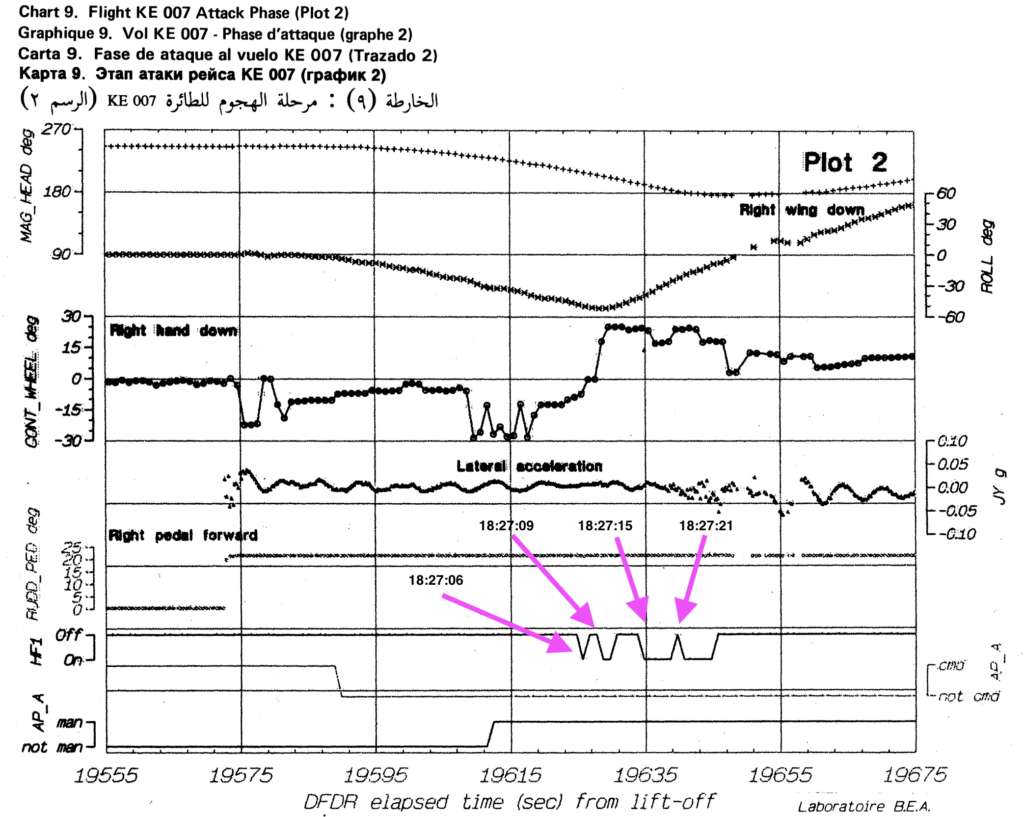
The DFDR (and the ICAO) show that approximately 3 minutes after liftoff KAL007 turned to a magnetic heading of 245deg and maintained that heading until missile impact. Yet in the ICAO 1983 report the simulation (done by Boeing) shows that a constant 246deg magnetic heading would make KAL007 miss Sakhalin completely and instead pass safely over Hokkaido. A 245 deg heading as indicated on the DFDR would bring its track even further south. (Image on left is better quality/easier to read but from book, image on right is the actual 1983 ICAO simulation chart.
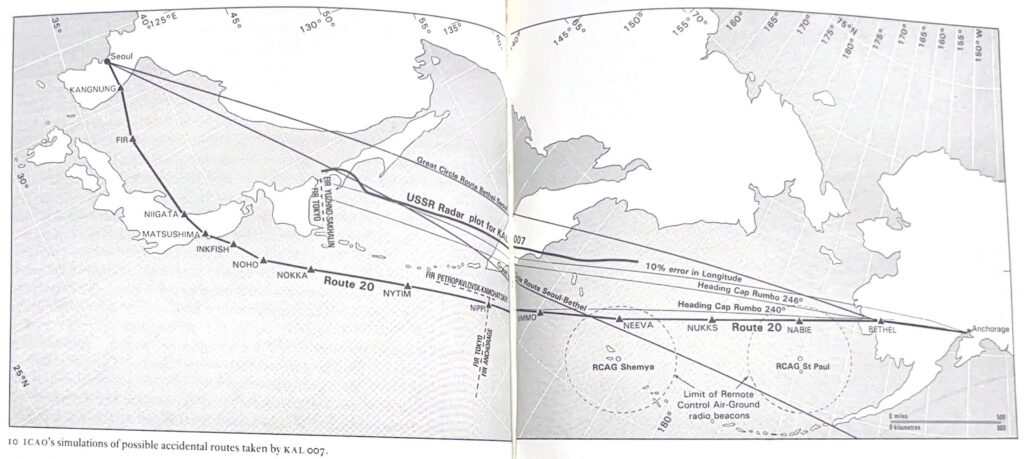
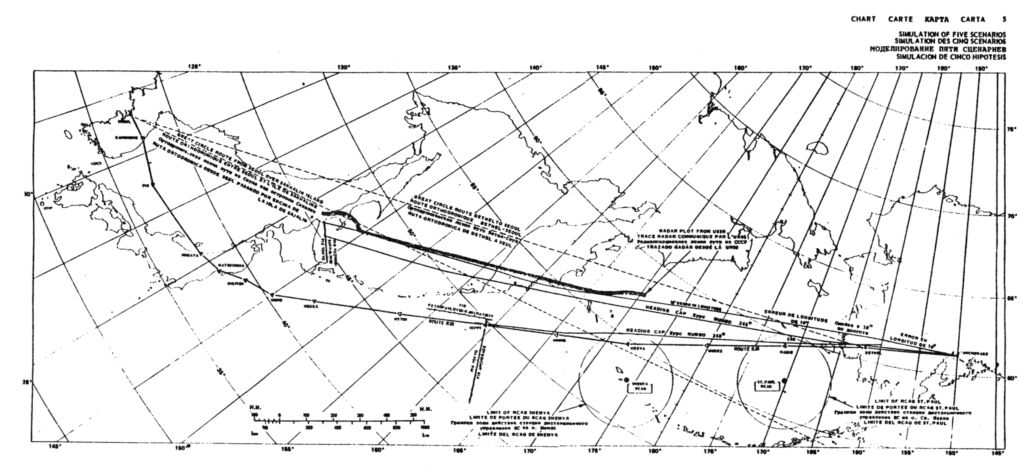
The ICAO report also completely ignores chart 12 ands 13 which clearly show the aircraft making numerous turns.
The ICAO report also fails to reference the publicly available radar provided by the Japanese in 1985 clearly showing multiple altitude and course changes in the final minutes of flight. Reproduced below.
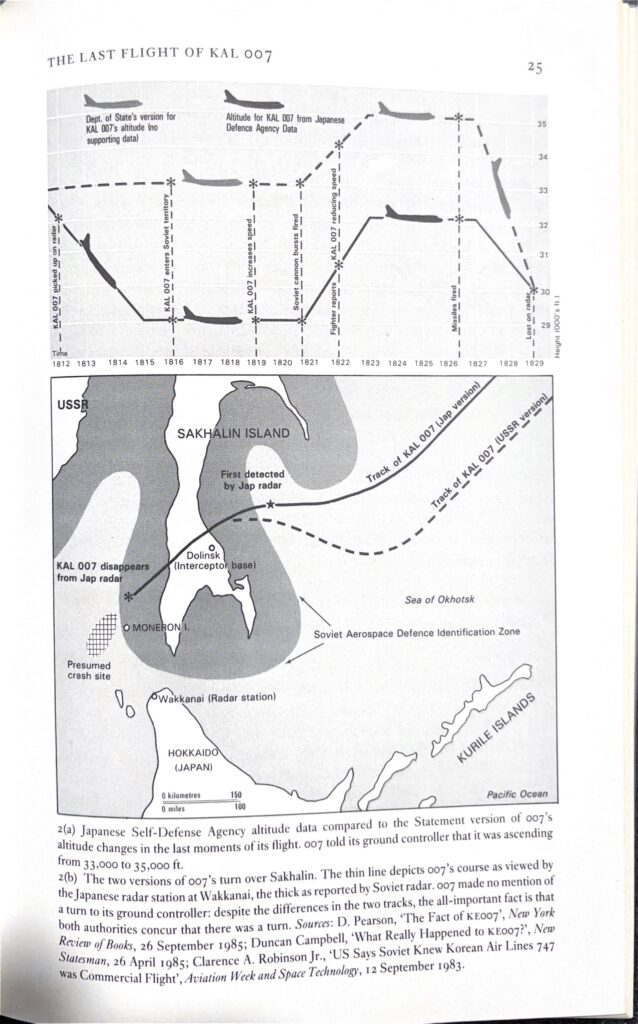
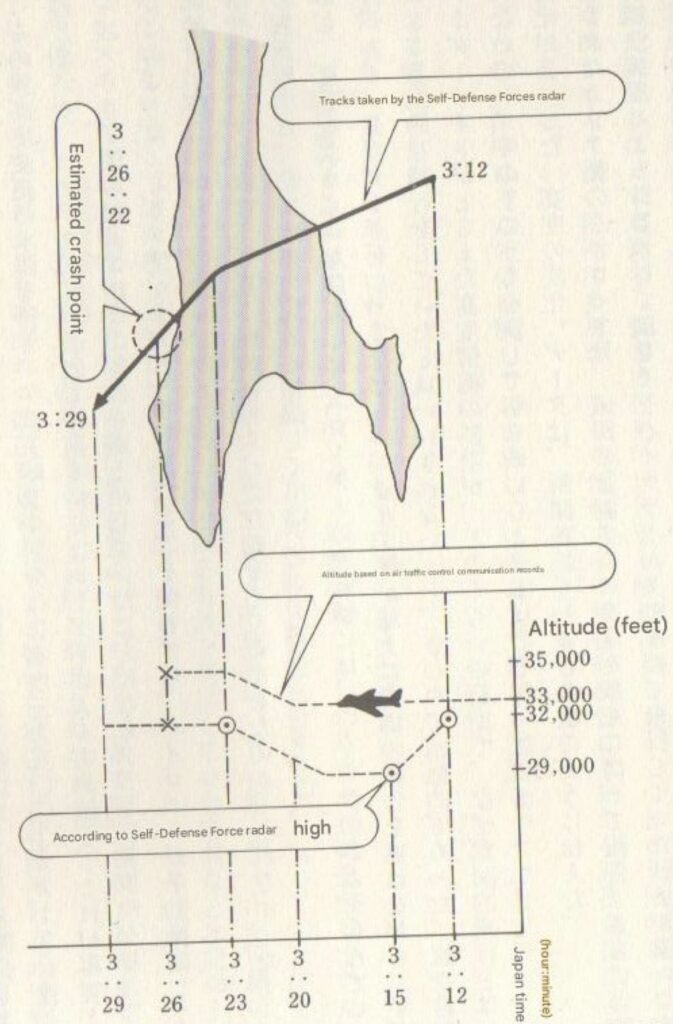
In summary, the DFDR data does not come from KAL007
There is also some question on the approach vector and take off vector as shown on the DFDR. Prior to the fateful flight KAL007 lands at 60deg and takes off at 315deg. The magnetic declination in 1983 at Anchorage was 24deg East which makes 36deg true and 291deg. This doesn’t seem to match Anchorage runway angles. However ICAO states these angles were inside allowable tolerances.
